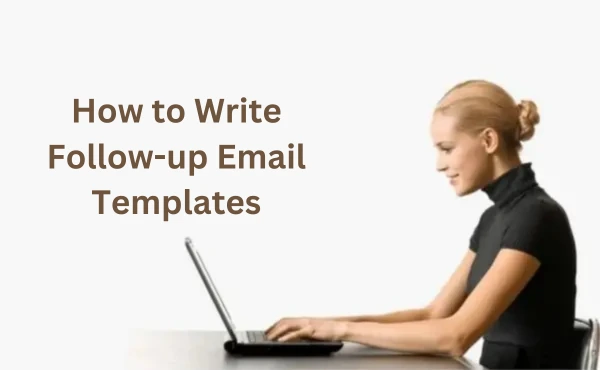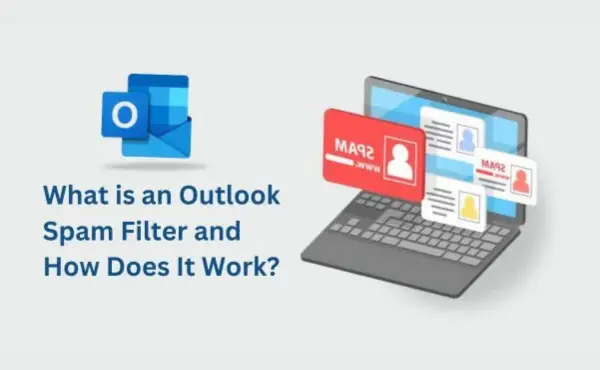Yes, Boost Inbox is designed to cater to businesses of all sizes and industries.
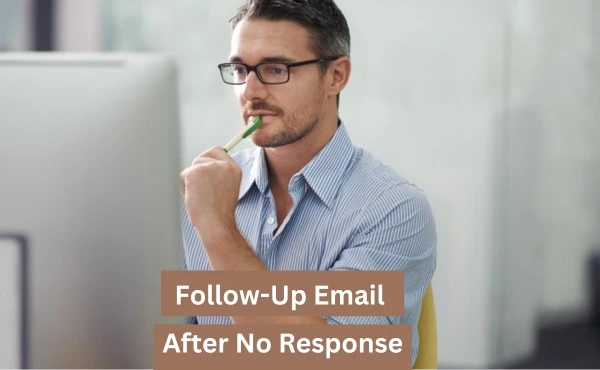
- What Is a Follow Up Email
- Why Send a Follow-Up Email After No Response?
- When to Send a Follow-Up Email After No Response
- How to Send a Follow-Up Email After No Response
- Best Practices for Writing Follow-Up Emails After No Response
- Second Follow-Up Email After No Response
- Second Follow-Up Email Tips
- Follow-Up Email Mistakes to Avoid
- Follow-Up Email Examples
- Follow-Up Email Templates
- 1.Following Up Email Templates After Sending Resources
- 2.Follow-Up Email Templates for a Meeting Reminder
- 3.Following Up Email After Meeting Templates
- 4.Following Up Email Templates After a Demo
- 5.Follow-Up Email Templates After No Response on Phone/Mobile
- 6.Follow-Up Email Templates for Contract Renewal
- 7.Follow-Up Email Templates After a Voicemail
- 8.Following Up Email Templates After a Trigger Event
- 9.Following Up Email Templates After Sending a Contract
- 10.Following Up Email Templates After They Submitted a Sales Inquiry
- 11.Following Up Email Templates After You Connected on Social Media
- 12.Following Up Email Templates After Prospect Attends Your Webinar
- 13.Following Up Email Templates After Networking Event
- 14.Following Up Email Templates After They Don't Renew Their Contract
- 15.Following Up Email Templates After Sending a Quote
- 16.Following Up Email Templates After Sending Product Samples
- 17.Following Up Email Templates After a Free Trial
- 18.Following Up Email Templates After the Prospect Asks You to Follow Up
- 19.Following Up Email Templates to Find the Right Contact
- 20.Following Up Email Templates After An Initial Follow-Up
- 21.Follow-Up Email Templates After Cold Email Promotion
- Follow-Up Email Templates
- Legal Compliance in Follow-Up Emails
- Conclusion
- FAQs
Follow-up emails are an important part of maintaining contact in business and communication. Whether you're trying to secure a transaction, schedule a meeting, or receive a response to a job application, a follow-up email ensures your message isn't ignored. People are busy, and emails can easily become lost in filled inboxes. A follow-up email works as a friendly reminder, showing that you are proactive and committed to the topic. Additionally, using an email warmup service can help improve email deliverability rates. For example, gradually increasing your email sending volume, maintaining consistent sending patterns, and engaging in natural email interactions can help establish sender reputation. Studies show that properly warmed-up email accounts can achieve deliverability rates of up to 90% compared to 50-70% for cold email accounts.
When you don't receive a response, it doesn’t always mean the other person isn’t interested. They may have forgotten, been distracted, or missed your initial email. Sending reminders politely after follow-up email maintains the momentum and shows your professionalism.
By sending intelligent follow-up emails, you may strengthen relationships, stay top of mind, and boost your chances of receiving what you want. In business, persistence in email communication is frequently the key to success, and a well-crafted follow-up email may make all the difference. Let's look at how to send the perfect follow-up email after no response.
What Is a Follow Up Email
A follow-up email is one you send to someone after your first email did not receive a response. It's a nice technique to remind the recipient of your prior message and encourage them to respond. Follow-up emails are useful in a variety of situations, such as reaching out to a prospective client, following up on a job application, or attempting to finish a transaction.
In professional situations, follow-up emails keep you on track and guarantee an important talks continue. For example, in sales, a follow-up email might remind an interested customer retention about your product or service while also showing its value. Client outreach email shows that you care about maintaining the relationship and want to continue working together. For employment queries, it could show your interest in the position and keep you on the hiring manager's mind.
A follow-up email's purpose is to keep communication flowing, clarify any misunderstandings, and provide any additional information that could help the receiver in responding. It's a basic yet effective tool for showing professionalism, determination, and dedication. Follow-up emails, when used correctly, can help to open doors and improve connections.
Why Send a Follow-Up Email After No Response?
Sending a follow-up email after no response is an important step in communication. It shows determination and commitment, Business email response techniques important for developing good professional email sign off. People frequently become distracted or overlook emails, so a friendly reminder may bring your message back to their attention.
There are many benefits to following up. First, it keeps you in the recipient's mind. Whether you're following up on a business opportunity, a job application, or a proposal, a follow-up email may show your commitment. It also promotes trust and keeps the conversation going, which is important for developing long-term relationships. Sometimes it even allows the other person to ask business inquiries or discuss worries that they had not before expressed.
On the other side, not sending a follow-up can be missed opportunity. The recipient may assume you are no longer interested, or your email may be lost and forgotten. In other situations, it may make you appear unprofessional or not concerned with the connection.
By sending a thoughtful follow-up email, you show respect for their time and a genuine desire to go forward. It's a simple activity that may greatly assist you achieve your goals.
When to Send a Follow-Up Email After No Response
Knowing when to send a follow-up email is important for keeping the conversation going without coming across as requesting. Timing for follow-up emails is important, you don't want to send your email too early or too late. A reasonable rule of guideline is to wait between 2-5 days following your initial email, depending on the urgency of your message. For example, if it's a job application, waiting a week may be appropriate.
If it's a sales pitch, a shorter period of 2-3 days works well. Being persistent is important, but so is respect for the other person's time. They may be busy or simply haven't had a chance to respond. Always try to create a balance between following up and giving them space.
Different situations need different approaches. For sales outreach, you can add extra value to your follow-up by providing a valuable resource or answering a query they may have. For job queries, communicate your passion for the position and gently remind them of your application. In networking, return to your first conversation or meeting to renew the connection.
By considering timing and context, you can make your follow-up emails both professional and effective.
Recommended follow-up timing by industry:
Sales Follow-ups
- First follow-up: 2-3 days after initial email
- Second follow-up: 4-5 days after first follow-up
- Third follow-up: 7-8 days after second follow-up
Recruitment Follow-ups
- First follow-up: 5-7 days after application
- Second follow-up: 7-10 days after first follow-up
Customer Service
- First follow-up: 24 hours after initial contact
- Second follow-up: 48 hours after first follow-up
Business Partnerships
- First follow-up: 3-4 days after initial email
- Second follow-up: 5-7 days after first follow-up
How to Send a Follow-Up Email After No Response
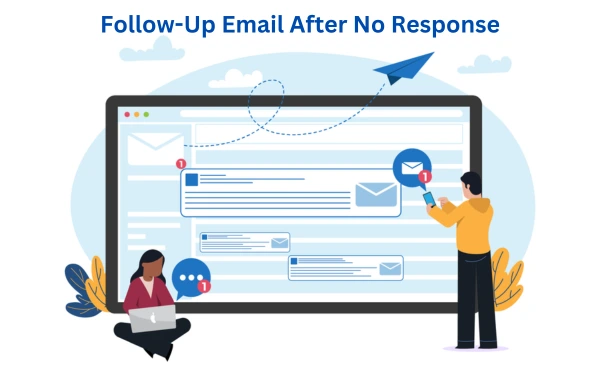
A follow-up email after no response should be polite, short, and informative. Begin by mentioning your initial email, restating your purpose, and asking for an update.How to write a polite follow-up, add a clear call to action.
Don’t Follow Up Too Quickly
When sending follow-up emails, timing is important. If you send a follow-up too quickly, you risk coming across as pushy or overly eager, which might turn people off. Before sending another email, make sure the recipient has had enough time to read and respond to the first one. A decent rule is to wait at least 2-3 days following your first email. In certain situations, such as Job application follow-up or formal inquiries, it is preferable to wait a week.
Rushing to follow up can add unnecessary pressure and make the recipient uncomfortable. Instead, be patient and professional by allowing them time to review your message. This approach shows that you respect their busy schedule and recognize that they may require time to answer.
The right time also depends on the situation. For example, in sales or networking, 2-3 days are usually enough. Waiting longer is generally a good idea in more formal situations, such as contract negotiations.
By being thoughtful about when to follow up, you can keep the conversation moving without becoming strong. Master professional email etiquette can create effective follow-ups to ensure answers and relationships.
Call-to-Action (CTA)
Every effective follow-up email must end with a clear call to action (CTA). A CTA indicates what you want the receiver to do next, making it easier for them to respond. Without a clear CTA, your email may leave the recipient not clear of what steps to follow, resulting in more delays or no response email at all.
A strong CTA is simple, straightforward, and relevant to the situation at hand. For example, if you're responding to a sales request, your CTA may be: "Let me know if we can schedule a quick 15-minute call to discuss further." For a job application, it may read: "Could you please share an update on the hiring process?"
Call to action in email are most effective when they are polite but specific. Instead than expressing something clear like "Let me know your thoughts," try saying "Can we schedule a meeting this week?". This ensures that the recipient understands exactly what to do and can take action quickly.
Including a CTA also indicates that you are serious and organized. It keeps the conversation focused and gives the recipient a clear path ahead, increasing their chances of receiving a response.
Attention grabbing email subject lines
The subject line is the first thing someone sees when they open your email, so make it stand out. A effective email subject line may increase the chance of your email getting opened. The idea is to make it accurate and eye-catching without being aggressive or misleading.
Instead of writing something vague like "Just Checking In," try something more specific and welcoming like "Following Up on Our Recent Conversation" or "Quick Question About Your Project Needs." These examples clearly express the aim of your business communication and grab attention without overpromising.
Avoid using manipulative terms like "URGENT" or "Final Notice" unless absolutely required. Marketing subject line could encourage the receiver to open the email, but they could damage your credibility and trustworthiness.
Personalizing your follow-up email subject line might increase its effectiveness. For example, "Update for [Recipient's Name]" or "Excited to Help with [Specific Project or Topic]" may appear more engaged.
A excellent subject line is simple, straightforward, and to the point. It creates the correct tone, increasing the chance that the recipient will open and respond to your email.A good subject lines for cold emails that get more responses.
Start with a Reminder of Your Last Interaction
When writing a follow-up email, start by reminding the recipient of your previous contact cards. This helps them remember who you are and why you are reaching out. Many people receive a large number of emails each day, therefore context is important.
For example, you may write: "I hope this email finds you well. I wanted to follow up on the email I sent on [date] about [a specific topic]. If you've met before, you could say something like, "It was great speaking with you during [event or meeting], and I wanted to continue our conversation about [topic]."
This approach is polite, straightforward, and to the point. It shows that you value the recipient's time by offering sufficient details without overloading them.
Avoid sounding forceful or believing that they intentionally ignored your previous message. Instead, maintain your tone polite and understanding. This builds the groundwork for the rest of your email and improves the chance that they will answer.
Starting with a gentle reminder shows professionalism and makes it easy for the recipient to interact with your communication. It's a small step that can go a long way toward continuing the conversation.
Avoid the Urge to Re-Send Your First Email
If you do not receive a response to your first email, it may be easy to simply resend the same message. However, this technique rarely works and might even be negative. Sending the same email again may appear boring or indifferent to the recipient. It also does not explain why they didn't answer in the first place.
Instead, spend a moment to improve your message's effectiveness. Start by reviewing your first email. Was your subject line enough for engaging follow-up emails? Have you properly explained the aim of your email and provided a call to action? Adjust these factors to help your follow-up stand out.
For example, you could say something like, "I wanted to follow up on my previous email regarding [topic]." I understand you may be busy, but I'd want to hear your opinions when you have a moment."
You can also provide new information or highlight a particular benefit to make your email more valuable to the receiver. By personalizing your follow-up, you show that you have thought about your communication and value their time.
This small effort makes a big difference, increasing the chances that your message gets noticed and responded to.
Keep Your Message Short and Concise
When sending a follow-up email, keep it short and to the point. People are busy and have little time to read lengthy, full communications. Shorter emails are more likely to be read and understood.
Being concise shows that you respect the recipient's time. Instead of duplicating your entire first email or going into too much detail, focus on the fundamentals. Remind them why you're contacting them, provide any updates or new information, and add a clear call-to-action in emails.
For example, here’s a concise follow-up template:
Subject Line: Quick Follow-Up on [Topic]
Hi [Recipient’s Name],
I hope you’re doing well. I wanted to follow up on my previous email about [brief mention of the topic]. Please let me know if you have any questions or need additional information. If it’s a good time, I’d love to schedule a quick chat to discuss further.
Looking forward to hearing from you!
Best regards,
[Your Name]
This kind of email is polite , straight to the point, and easy to read. It increases the chances that the recipient will respond while maintaining a professional tone.
Show Empathy, Not Frustration
When sending a follow-up email after no reply, it's important to stay positive and friendly, even if you feel overlooked. Displaying frustration may make the other person less likely to reply. Instead, concentrate on being understanding and caring.
Start your email by noting that the recipient may be busy. You may add, "I hope this email finds you well." I understand you may have a lot on your plate. This shows you are respectful of their time and situation.
Maintain a polite and professional tone. Avoid using aggressive language, such as "You didn't reply to my last email." Instead, say something like, "I just wanted to follow up in case my last message got missed."
Empathy creates a connection and keeps the conversation going. For example, you can say, "If now is not a good time, I completely understand—just let me know when it is more convenient for you."
By showing nice and understanding, you create a good impression and make it simpler for the recipient to respond. Patience and empathy in communication can help turn silence into a good conversation.
Include Social Proof or Email
Including social proof or email proofreading is an effective method to build trust and it shows why the recipient should reply. Social proof is evidence that others have benefited from what you provide. For example, you might add a quick testimonial from a satisfied client or a success story from a case study. This shows to the receiver that your solution works and that others trust you.
Adding value means providing something valuable, such as a link to an article, a tool, or a guide that will benefit the recipient. For example, if you're offering marketing services, you might include a link to a blog post on increasing social media engagement. This not only shows that you care about their achievement, but it also makes your email more informative and less like an advertisement.
Make sure it is relevant to the recipient's needs. If they sense that you are providing contact information or proof that is relevant to their goals, they are more likely to engage. When sharing this via email, be simple, clear, and polite; the goal is to develop trust, not overwhelm them.
Including specific, verifiable social proof can help build trust. For example:
- Customer testimonials with full names and companies (with permission)
- Specific case study results with measurable metrics
- Industry awards or certifications
- Published client reviews from verified platforms
- Media mentions or press coverage
Best Practices for Writing Follow-Up Emails After No Response
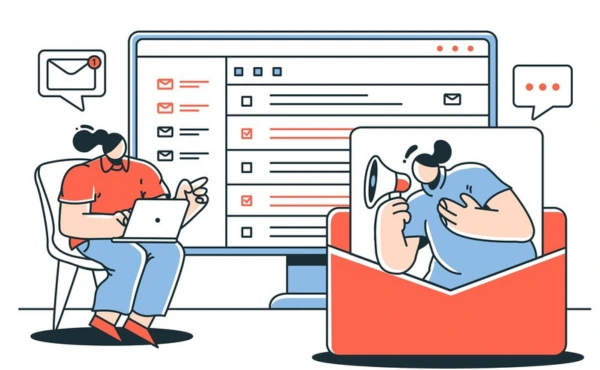
When sending a follow-up email after no response, it is important to do it correctly. Following these recommended practices will boost your chances of receiving a response and developing a stronger relationship. Here you can check the email best practices,
Choose the Right Timing
Timing is important when sending a follow-up email. If you send it too soon, the recipient may not have had time to respond. If you wait too long, they may forget about your initial email. A good rule of practice is to wait around 2-3 days after the first message you sent before following up. This provides the receiver a chance to read your message while still keeping you in their mind. Check your email marketing or CRM software for ideal timings.
Provide More Information
In your follow-up email, don't just repeat your original message. Give them something extra. Share any updates, new information, or useful resources. This can remind them of the value you're providing and could encourage them to respond. For example, if you're selling a product, you could include a link to a relevant blog article or a new feature that they could find valuable.
Offer Value
When writing a follow-up, always consider how you can help the person you're emailing. Instead than simply asking for a response, consider leading something helpful. For example, you may give beneficial suggestions, informative articles, or unique ideas. Showing that you care about their needs increases their chances of responding. People are more interested when they believe they are receiving something beneficial in return.
Show Empathy
People get busy, and your email may have been lost in their inbox. Empathy is key in your follow-up; let them know you understand their busy schedule. For example, you could remark, "I know you're probably busy, but I just wanted to check in." This makes you appear nice and kind, rather than aggressive or irritated.
Create Urgency
Sometimes, Creating urgency in emails, even carefully, could lead to a speedier response. However, you should avoid placing too much pressure on the person. You may achieve this by suggesting a limited-time promotion or a deadline. Examples include: "This special offer expires in two days, and I didn't want you to miss out." This encourages the recipient to act quickly, but it should always be done politely and respectfully.
Be Direct and Get to the Point
People do not have time for lengthy, complex follow-up emails. Keep your email simple and clear. Tell the recipient why you're emailing and what action you want them to take. In this case, you might say: "I wanted to follow up and see if you're interested in email scheduling a meeting" or, "I'd love to hear your thoughts on my proposal." Being direct allows the reader to quickly understand what you require.
Be Flexible
The person you're emailing may be busy or on a different schedule than you. Be flexible and ready to work around their requirements. In your follow-up, you can offer to change your meeting time or give them alternative options for how to respond. Like the following: "Please let me know if another time works better for you" and "I'm happy to connect at your convenience." This shows your respect for their time and willingness to make things easy for them.
Optimize for Mobile Readers
With over 60% of emails being opened on mobile devices, ensuring your follow-up emails are mobile-friendly is crucial:
- Keep subject lines under 30 characters for full mobile display
- Use single-column layouts for easy mobile reading
- Make CTAs large enough for thumb-clicking (at least 44x44 pixels)
- Use readable fonts (minimum 14px for body text)
- Keep paragraphs short (2-3 sentences maximum)
- Test your emails across different mobile devices and email clients
Second Follow-Up Email After No Response
When you've sent a follow-up email and haven't received a response, it's time to send a second one. This might be tough, but if done correctly, it can help you reconnect with the person without disturbing them. Let's look at two key tips for creating a second follow-up email.
Adjust Your Close Every Time You Don’t Get a Response
If the person has not responded to your earlier emails, you should change your approach. This doesn't mean completely modifying your message every time but instead improving it to make it more successful. Consider what might not have worked in your previous emails. Was the call to action (CTA) clear? Have you asked too much? Maybe you didn't provide enough value?
In your second follow-up, try a slightly different closing statement. For example:
- Instead of saying, “Let me know if you’re interested,” you can say, “Would you be available for a quick 10-minute call to discuss this further?” This makes it easier for the recipient to take action.
- If your first email asked for feedback, your second follow-up could add something like, “I’d love to hear your thoughts on this when you have a moment.” It shows patience and keeps the conversation open rates.
Remember to stay polite and professional. Adjusting your message shows that you’re paying attention and genuinely trying to connect, not just sending the same generic email repeatedly.
Avoid "Breakup Emails"
A "breakup email" is one where you show that the communication has ended because the receiver has not answered. For example, writing, "Since I haven't heard from you, I'll assume you're not interested," may come out as giving up. While this follow-up strategy appears to increase urgency, it can have the opposite effect. The recipient may feel pushed or think you are dismissive, which can reduce your chances of receiving a response later.
Instead of closing the door, keep the conversation open in your second follow-up. A better way to phrase this could be:
- “I understand things get busy, but I wanted to follow up one last time to see if this is something you’re interested in. I’m happy to provide more information or answer any questions.”
This approach is friendly, respectful, and leaves room for them to respond whenever they’re ready. Even if they’re not interested right now, they might appreciate your professionalism and keep you in mind for the future.
Second Follow-Up Email Tips
- Be Patient: Do not speed up the process. Allow some time in between follow-ups to avoid overloading the receiver.
- Stay Helpful: Use this email as another opportunity to add value or answer queries.
- Keep it Short: Respect the recipient's time by making your message clear and brief.
Follow-Up Email Mistakes to Avoid
When sending a follow-up email after receiving no answer, you must use care. Small mistakes can make a major difference in how quickly you receive a response. Here are some frequent mistakes individuals make when writing follow-up emails and how to avoid them:
Missing Personal Touches
Personalizing your follow-up email is one of the most simple ways to make it stand out. If you send a generic "Hello" or "Dear Sir/Madam" message, it may appear that you didn't put much effort into it. People are more likely to respond when they believe the email was sent for them directly. Try using their name in the greeting and mentioning anything particular from a previous discussion or email. Like the one above: "I really enjoyed our last conversation about [topic]." This shows that you are paying attention and that your message is not simply a mass email.
Skipping Key Information
Clarity is important when writing a follow-up email. If you leave out important information, the recipient may not understand what you're referring to or what action you want them to take. Always include key information, such as the prior email's subject, what you're following up on, and any action you request. For example, if you're following up on a meeting request, add something like, "I wanted to follow up on my email from last week regarding scheduling a meeting." This makes it easier for the recipient to understand what you're saying without searching through previous emails.
Forgetting to Proofread
Sending an email with spelling or grammar errors might make you look unprofessional and lower your chances of receiving a response. Before clicking send, always proofread your email. Check for small mistakes, such as missing words or improper spelling. A minor error may not seem like a huge issue, but it might create a negative impression. Taking a few extra seconds to review your email shows you are detail-oriented and concerned about your message.
Not Adding a Call-to-Action
A call-to-action (CTA) is a straightforward request that informs the recipient what to do next. If you don't include a CTA in your email, the receiver may be confused what you want of them. For example, if you want them to respond, make it obvious by saying something like, "Please let me know your availability for a meeting next week." Or, if you want them to take action, such as studying a paper, say, "I would appreciate your feedback on the proposal by Friday." Without a CTA, your follow-up may lack direction and leave them confused of what steps to take.
Sounding Pushy or Aggressive
While it is important to follow up, avoid being forceful or aggressive. Being aggressive in a follow-up email can turn people off and make them feel uncomfortable. Avoid statements like "I've been waiting for your response for too long" or "I need an answer immediately." These communications may cause the recipient to feel pressurized. Instead, try to be nice and caring, such as saying, "I know you're busy, but I wanted to check in about my last email." A polite tone keeps conversation open and inviting.
Not Saying Thank You
Even if you have not received a response, it is always polite to thank the person for their time. A simple "thank you" can go a long way toward creating an excellent relationship. It shows that you value their attention and understand that they may be busy. For instance, you may say, "Thank you for taking the time to read my email" or "I appreciate you considering my request." Even when following up on an unanswered email, expressing gratitude promotes goodwill and keeps conversations friendly.
Follow-Up Email Examples
A follow-up email is an important tool for communication, especially when you want to remind or push the receiver to take action. The following are examples and templates for a range of situations in which follow-up emails are required, ensuring that you keep a professional and respectful tone while moving the conversation forward.
Follow-Up Email Templates
Follow-up email templates are an effective way to keep professional connection following an initial contact or activity. These templates serve to simplify the follow-up strategies process by ensuring consistency, professionalism, and clarity.
Whether you're reminding someone about an earlier email, organizing a meeting, or collecting feedback, a well-crafted follow-up email may inspire action and keep your conversation moving.
Effective email follow-up templates typically includes of a clear subject line, a brief introduction, and a polite reminder of the before conversation. It also includes a call-to-action (CTA) that directs the receiver to the next step, which could be scheduling a meeting, making a decision, or providing more information.
Personalized email templates can save time while ensuring important details are not left out, such as addressing the recipient by name, summarizing previous conversations, and providing value in the follow-up.
Customized templates can help you communicate efficiently and effectively in a variety of situations, like following up after sending resources, attending a meeting, or even missing a call. Furthermore, placing email personalization into the template, such as mentioning the recipient's interests or issues, can increase their chances of receiving a response.
In short, follow-up email templates help you stay organized, timely, and respectful while building stronger connections with your contacts.
1.Following Up Email Templates After Sending Resources
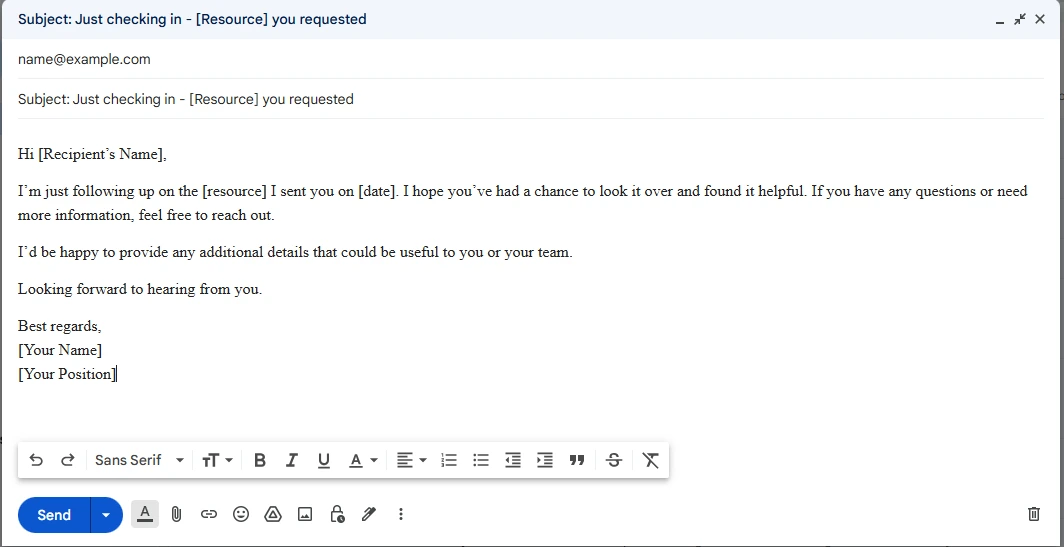
When you send resources such as articles, catalogs, or case studies to someone and do not receive a response, it is important to follow up in a nice, non-pushy way. A good follow-up email reminds the recipient of the contents you sent and encourages them to take action.
Here’s a simple example:
Subject: Just checking in - [Resource] you requested
Body: Hi [Recipient’s Name],
I’m just following up on the [resource] I sent you on [date]. I hope you’ve had a chance to look it over and found it helpful. If you have any questions or need more information, feel free to reach out.
I’d be happy to provide any additional details that could be useful to you or your team.
Looking forward to hearing from you.
Best regards,
[Your Name]
[Your Position]
This email is polite, clear, and keeps the focus on offering further help or information.
2.Follow-Up Email Templates for a Meeting Reminder
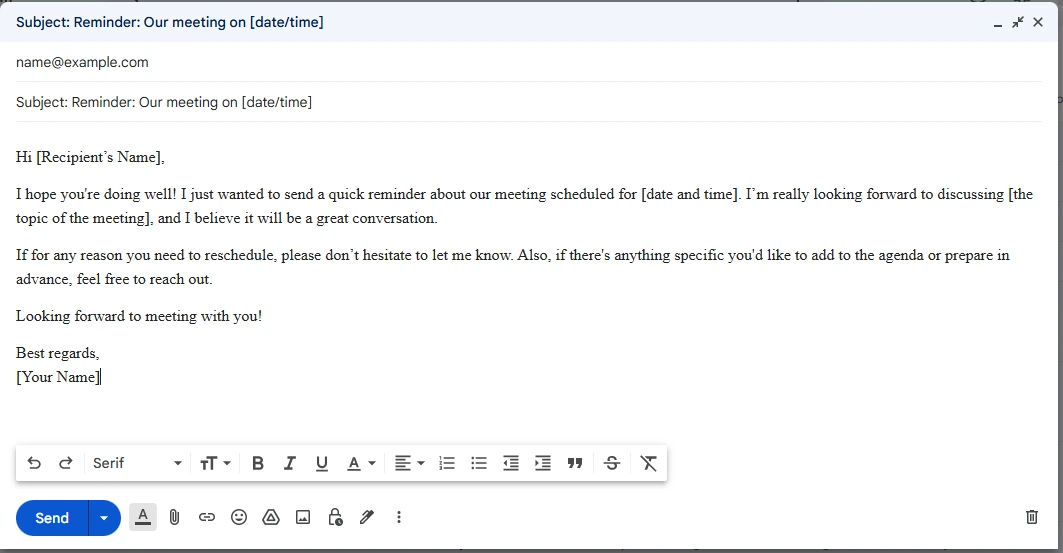
When you need to remind someone about an upcoming meeting details, it's important to be polite and clear.
Here’s how an email reminder strategy can help achieve that with a straightforward follow-up email:
Subject: Reminder: Our meeting on [date/time]
Body: Hi [Recipient’s Name],
I hope you're doing well! I just wanted to send a quick reminder about our meeting scheduled for [date and time]. I’m really looking forward to discussing [the topic of the meeting], and I believe it will be a great conversation.
If for any reason you need to reschedule, please don’t hesitate to let me know. Also, if there's anything specific you'd like to add to the agenda or prepare in advance, feel free to reach out.
Looking forward to meeting with you!
Best regards,
[Your Name]
Meeting reminder email template is short, friendly, and ensures that the recipient has all the details they need. It also leaves room for rescheduling or adding important items to the meeting.
3.Following Up Email After Meeting Templates
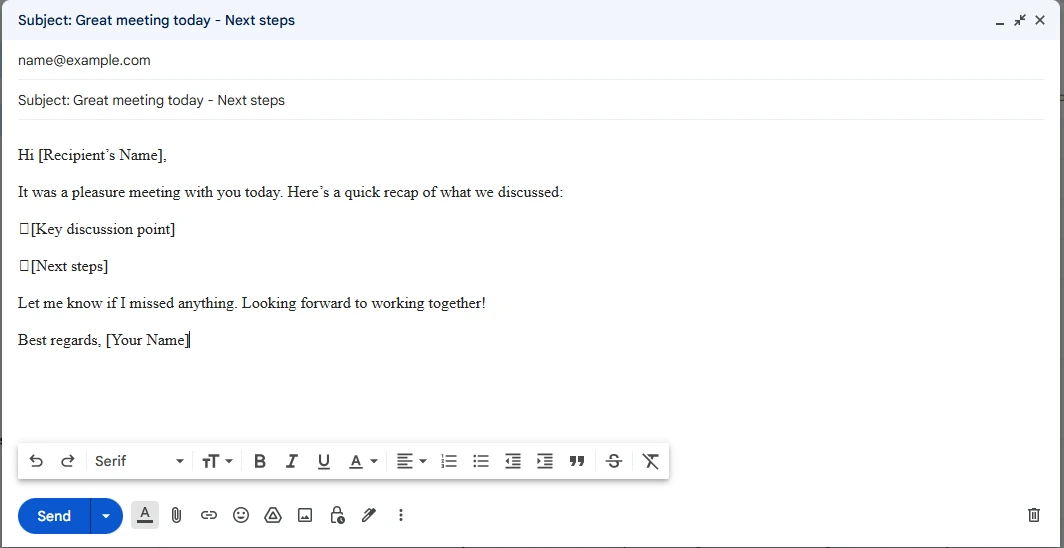
Following up email after meeting is important for continuing the conversation and ensuring everyone is on the same page. A well-written meeting follow-up email can confirm what was discussed and lay out the next actions.
Start your email by thanking the receiver for their time and expressing how much you appreciated the encounter. Then, briefly summarize the most important points or ideas that were presented, highlighting any important ones. It's also a good idea to indicate the next steps, such as organizing another meeting, delivering further information, or following up on specified tasks.
This email maintains the momentum and shows your commitment to the discussion. It also allows the recipient to clarify anything you may have missed or forgotten to mention
Here’s a simple example:
Subject: Great meeting today - Next steps
Body:Hi [Recipient’s Name],
It was a pleasure meeting with you today. Here’s a quick recap of what we discussed:
- [Key discussion point]
- [Next steps]
Let me know if I missed anything. Looking forward to working together!
Best regards,
[Your Name]
4.Following Up Email Templates After a Demo
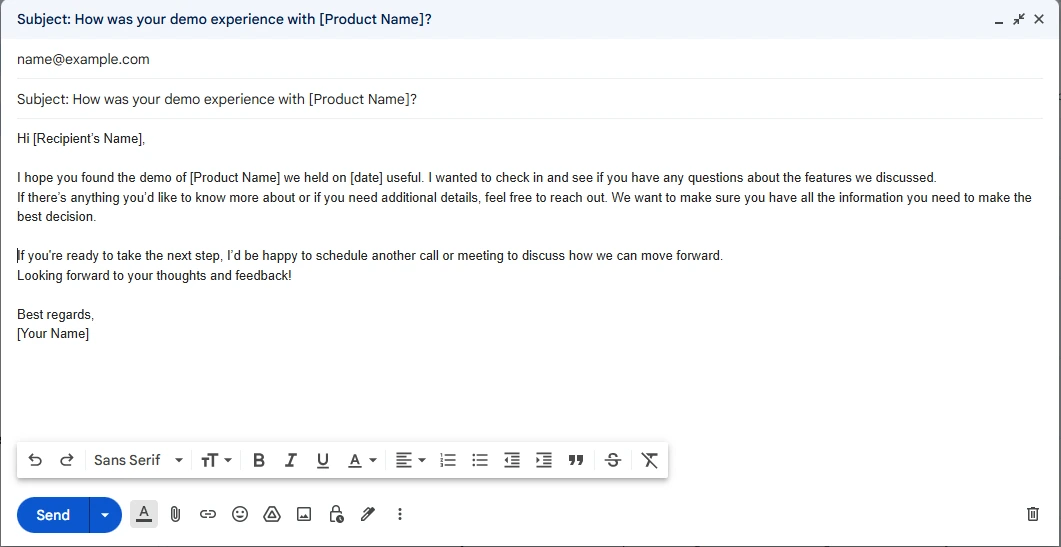
Demo follow-up or product demonstration, it is important to follow up to find out how the receiver felt about the product and if they have any questions. A smart follow-up after demo or presentationmay encourage them to continue further or provide request for feedback.
Here’s a simple example:
Subject: How was your demo experience with [Product Name]?
Body:Hi [Recipient’s Name],
I hope you found the demo of [Product Name] we held on [date] useful. I wanted to check in and see if you have any questions about the features we discussed.
If there’s anything you’d like to know more about or if you need additional details, feel free to reach out. We want to make sure you have all the information you need to make the best decision.
If you're ready to take the next step, I’d be happy to schedule another call or meeting to discuss how we can move forward.
Looking forward to your thoughts and feedback!
Best regards,
[Your Name]
5.Follow-Up Email Templates After No Response on Phone/Mobile
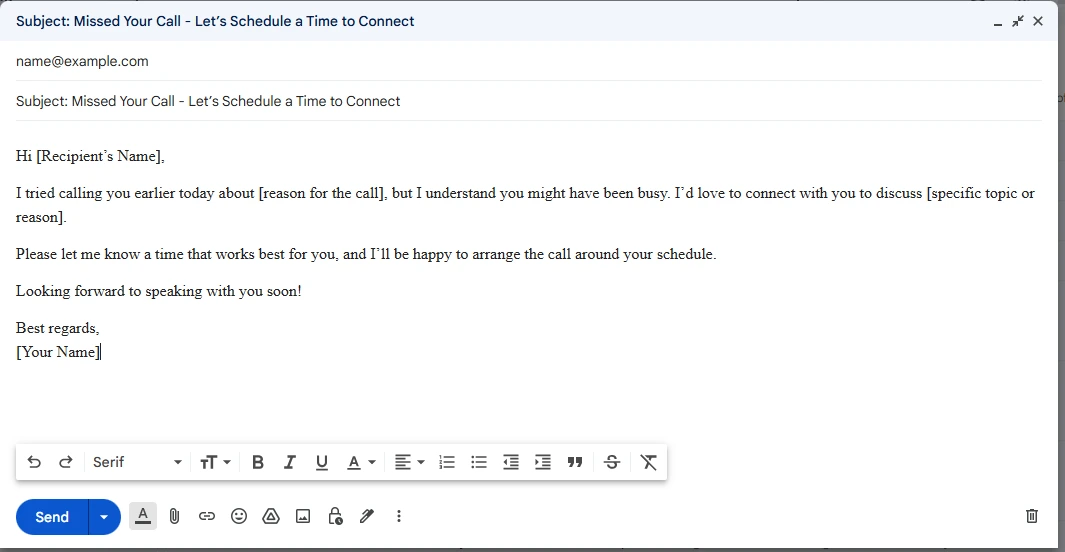
When someone doesn’t answer your phone call, a polite and professional follow-up email can help you reconnect. Follow-up after missed call is important to be understanding and flexible, showing that you respect their time.
Here’s an example of what you can write:
Subject: Missed Your Call - Let’s Schedule a Time to Connect
Body:Hi [Recipient’s Name],
I tried calling you earlier today about [reason for the call], but I understand you might have been busy. I’d love to connect with you to discuss [specific topic or reason].
Please let me know a time that works best for you, and I’ll be happy to arrange the call around your schedule.
Looking forward to speaking with you soon!
Best regards,
[Your Name]
This approach keeps the message clear, respectful, and professional, giving the recipient the flexibility to respond when it’s convenient for them.
6.Follow-Up Email Templates for Contract Renewal
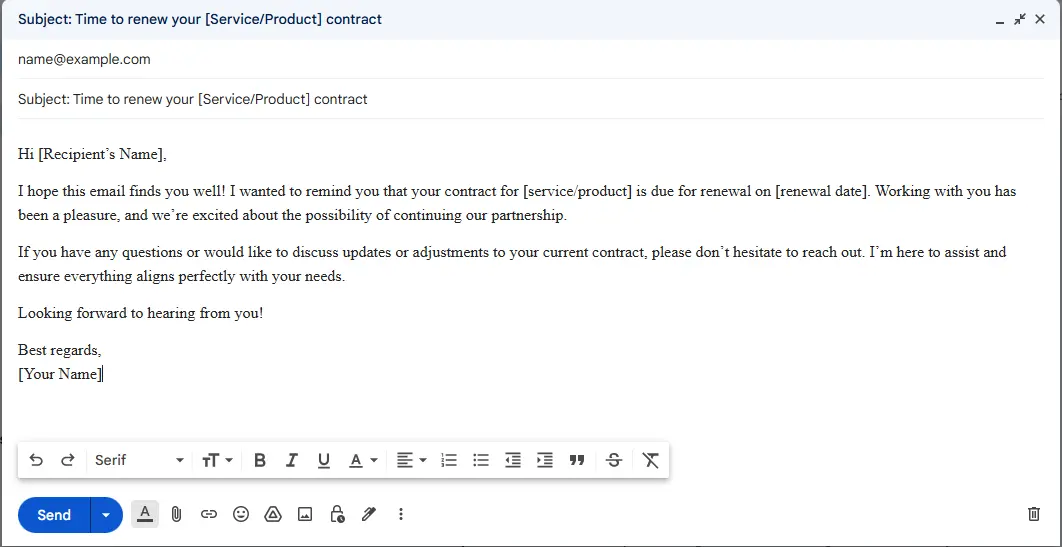
Email for contract renewal discussion maintaining a great relationship with your client during contract renewals requires you to keep your communication clean and professional. A renewal email should remind the recipient of the coming date while expressing eagerness for maintaining your collaboration. You can set a drip campaign for sending automated emails for renewal and reminders.
Here’s a simple example:
Subject: Time to renew your [Service/Product] contract
Body:Hi [Recipient’s Name],
I hope this email finds you well! I wanted to remind you that your contract for [service/product] is due for renewal on [renewal date]. Working with you has been a pleasure, and we’re excited about the possibility of continuing our partnership.
If you have any questions or would like to discuss updates or adjustments to your current contract, please don’t hesitate to reach out. I’m here to assist and ensure everything aligns perfectly with your needs.
Looking forward to hearing from you!
Best regards,
[Your Name]
Client renewal reminders need to approach this in a way that is polite, informative, and focused on collaboration.
7.Follow-Up Email Templates After a Voicemail
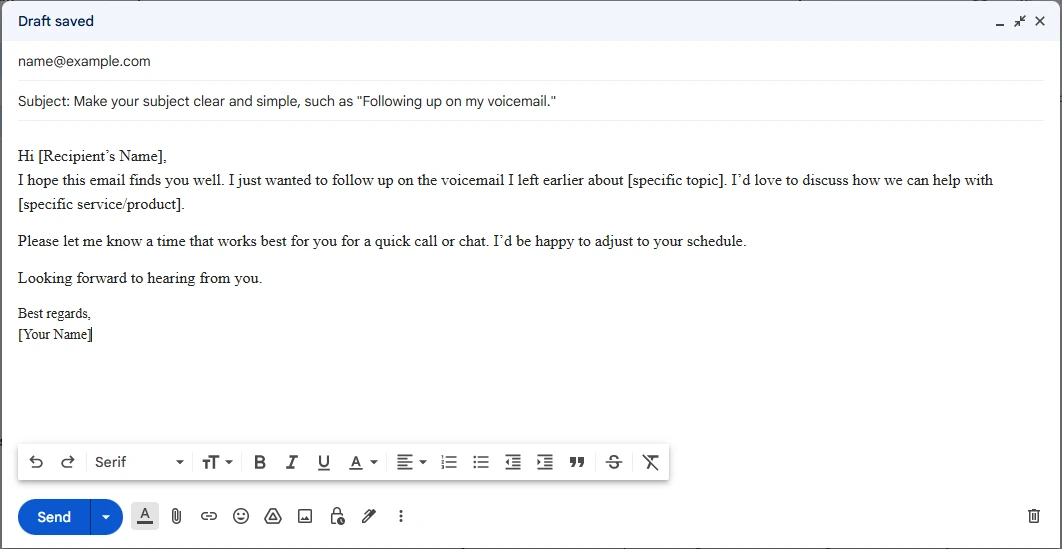
When you leave a voicemail but don’t hear back, a follow-up email can gently remind the recipient to respond without being intrusive.
Here’s a simple example:
Subject: Make your subject clear and simple, such as "Following up on my voicemail."
Body: "Hi [Recipient’s Name],
I hope this email finds you well. I just wanted to follow up on the voicemail I left earlier about [specific topic]. I’d love to discuss how we can help with [specific service/product].
Please let me know a time that works best for you for a quick call or chat. I’d be happy to adjust to your schedule.
Looking forward to hearing from you.
Best regards,
[Your Name]"
This email is polite, straightforward, and encourages are responding to an email by showing flexibility and respect for their time.
8.Following Up Email Templates After a Trigger Event
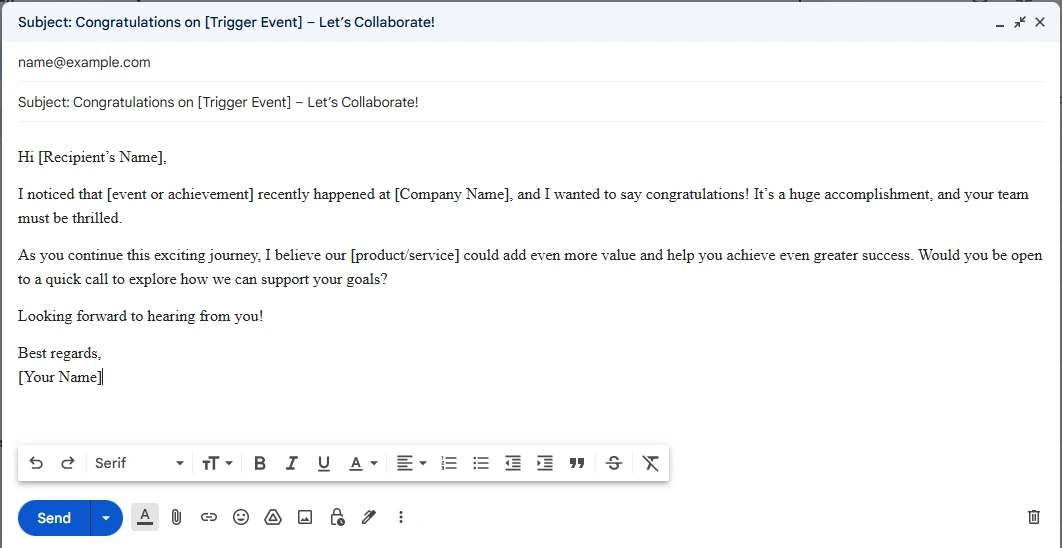
Trigger events, such as a company milestone, industry recognition, or product launch, are excellent opportunities to connect with others. A timely follow-up email can show that you are attentive and truly concerned in their achievement.
Here’s a simple example:
Subject: Congratulations on [Trigger Event] – Let’s Collaborate!
Body:Hi [Recipient’s Name],
I noticed that [event or achievement] recently happened at [Company Name], and I wanted to say congratulations! It’s a huge accomplishment, and your team must be thrilled.
As you continue this exciting journey, I believe our [product/service] could add even more value and help you achieve even greater success. Would you be open to a quick call to explore how we can support your goals?
Looking forward to hearing from you!
Best regards,
[Your Name]
9.Following Up Email Templates After Sending a Contract
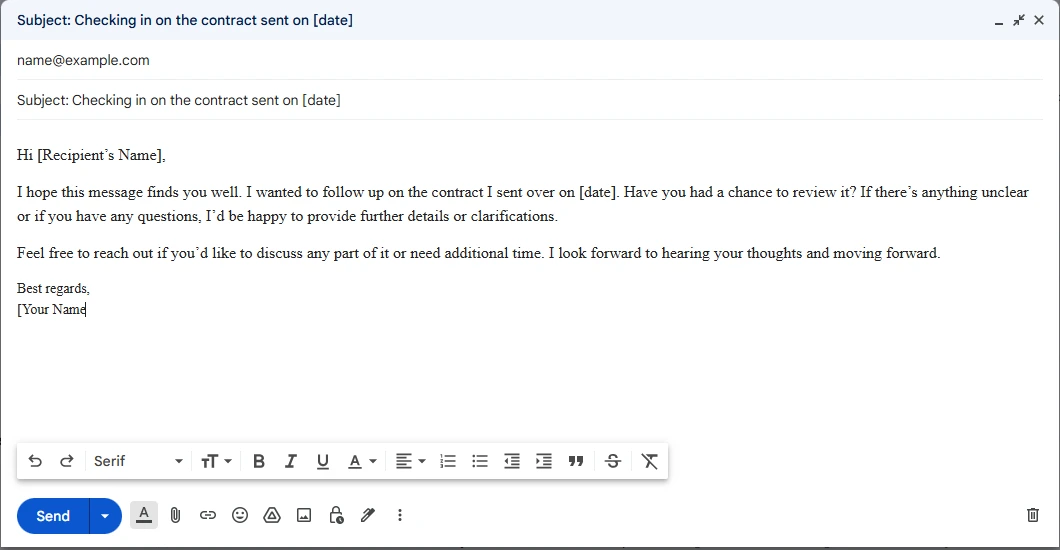
Once you’ve sent a contract, following up is a critical step to ensure everything is clear and to keep the process moving smoothly.Following up after sending contract is simple and polite follow-up techniques can make a big difference.
Here’s a simple example:
Subject: Checking in on the contract sent on [date]
Body:Hi [Recipient’s Name],
I hope this message finds you well. I wanted to follow up on the contract I sent over on [date]. Have you had a chance to review it? If there’s anything unclear or if you have any questions, I’d be happy to provide further details or clarifications.
Feel free to reach out if you’d like to discuss any part of it or need additional time. I look forward to hearing your thoughts and moving forward.
Best regards,
[Your Name]
This email is straightforward, polite, and lets the recipient know you're available for assistance without being forceful.
10.Following Up Email Templates After They Submitted a Sales Inquiry
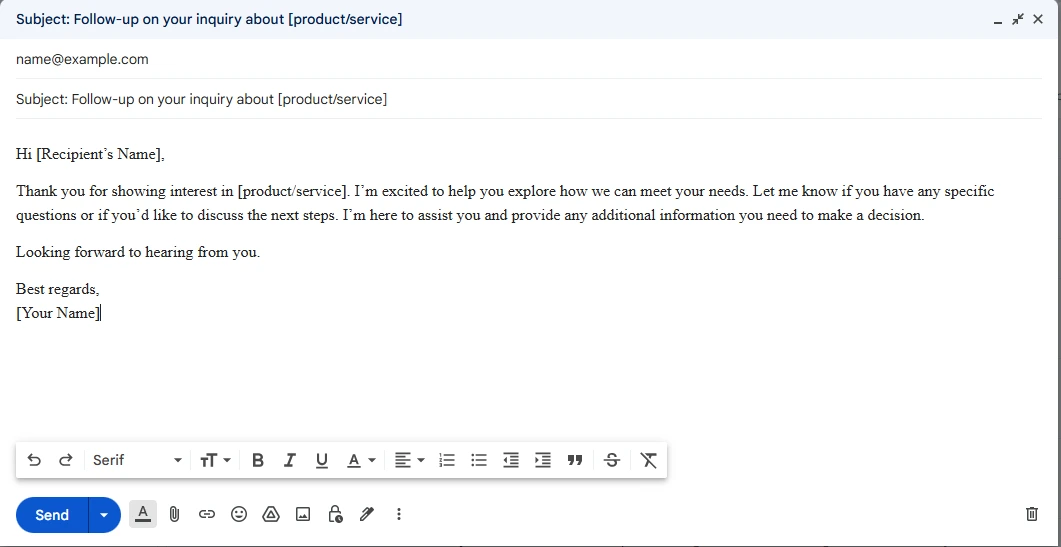
When someone sends a sales inquiry, Sales email follow-up is important to follow up quickly to maintain their interest. Start by thanking them for inquiring about your product or service. Recognize their efforts to inquire, as this creates a positive relationship. Use a polite and professional email reminders tone in your email to make them feel appreciated. You can use these email templates to follow up with inbound leads.
Here’s the sales email follow-up's simple example:
Subject: Follow-up on your inquiry about [product/service]
Body:Hi [Recipient’s Name],
Thank you for showing interest in [product/service]. I’m excited to help you explore how we can meet your needs. Let me know if you have any specific questions or if you’d like to discuss the next steps. I’m here to assist you and provide any additional information you need to make a decision.
Looking forward to hearing from you.
Best regards,
[Your Name]
After sales inquiry follow-up approach encourage the engagement and positions you as helpful and responsive.
11.Following Up Email Templates After You Connected on Social Media
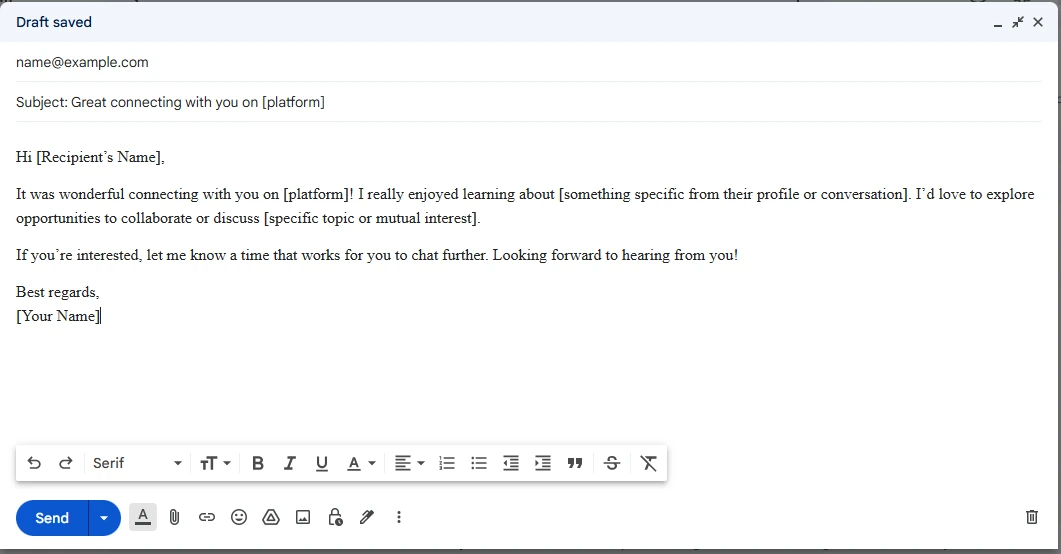
Social media is an excellent tool for meeting new people and expanding your network. After connecting with someone, sending a friendly and polite email reminders can increase the friendship and open the way for collaboration. A well-create effective follow-up email structure should mention the medium via which you connected and express genuine interest in continuing the conversation.
Here’s a simple example:
Subject: Great connecting with you on [platform]
Body:Hi [Recipient’s Name],
It was wonderful connecting with you on [platform]! I really enjoyed learning about [something specific from their profile or conversation]. I’d love to explore opportunities to collaborate or discuss [specific topic or mutual interest].
If you’re interested, let me know a time that works for you to chat further. Looking forward to hearing from you!
Best regards,
[Your Name]
12.Following Up Email Templates After Prospect Attends Your Webinar
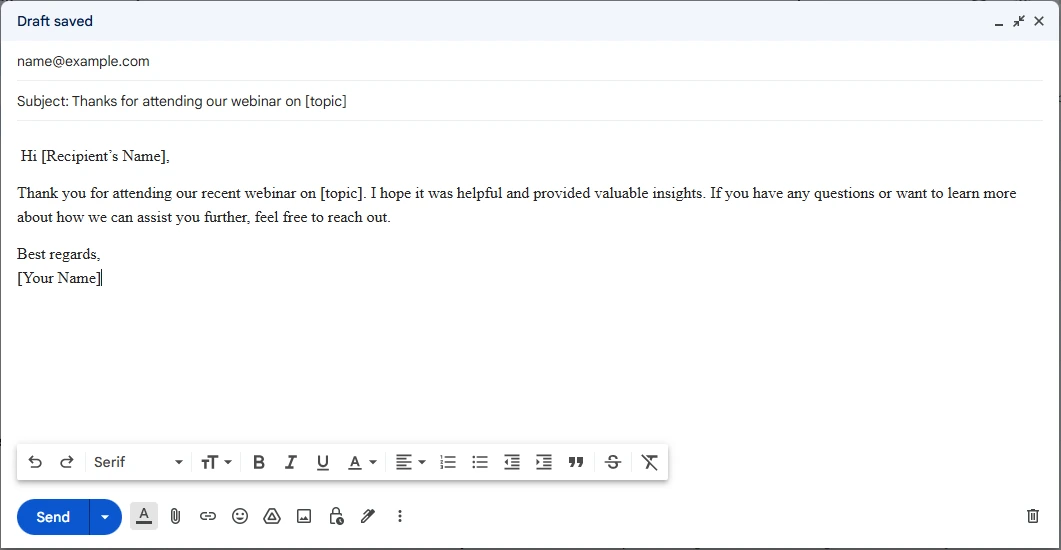
Engagement email after webinar are a wonderful approach to engage prospects and offer them with useful information. After someone joins your webinar, send a thank-you email. This not only expresses gratitude for their time, but also opens the door to future discourse.
Here’s a simple example:
Subject: Thanks for attending our webinar on [topic]
Body: Hi [Recipient’s Name],
Thank you for attending our recent webinar on [topic]. I hope it was helpful and provided valuable insights. If you have any questions or want to learn more about how we can assist you further, feel free to reach out.
Best regards,
[Your Name]
This type of follow-up shows your willingness to support their needs and can lead management systems to meaningful next steps.
13.Following Up Email Templates After Networking Event
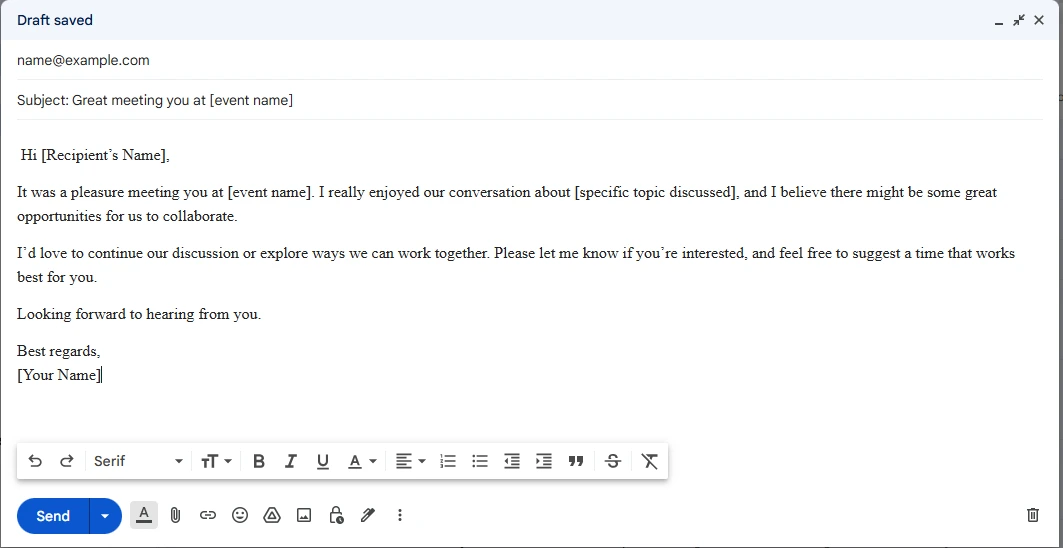
After meeting someone at a networking event, it's important to follow up and maintain the connection. Network event improves the relationship and may lead to future opportunities. A simple, pleasant email can go a long way.
Here’s a simple example:
Subject: Great meeting you at [event name]
Body:Hi [Recipient’s Name],
It was a pleasure meeting you at [event name]. I really enjoyed our conversation about [specific topic discussed], and I believe there might be some great opportunities for us to collaborate.
I’d love to continue our discussion or explore ways we can work together. Please let me know if you’re interested, and feel free to suggest a time that works best for you.
Looking forward to hearing from you.
Best regards,
[Your Name]
By sending this email, reconnecting after business event you remind the person of your conversation, express interest in future collaboration, and keep the lines of communication open.
14.Following Up Email Templates After They Don't Renew Their Contract
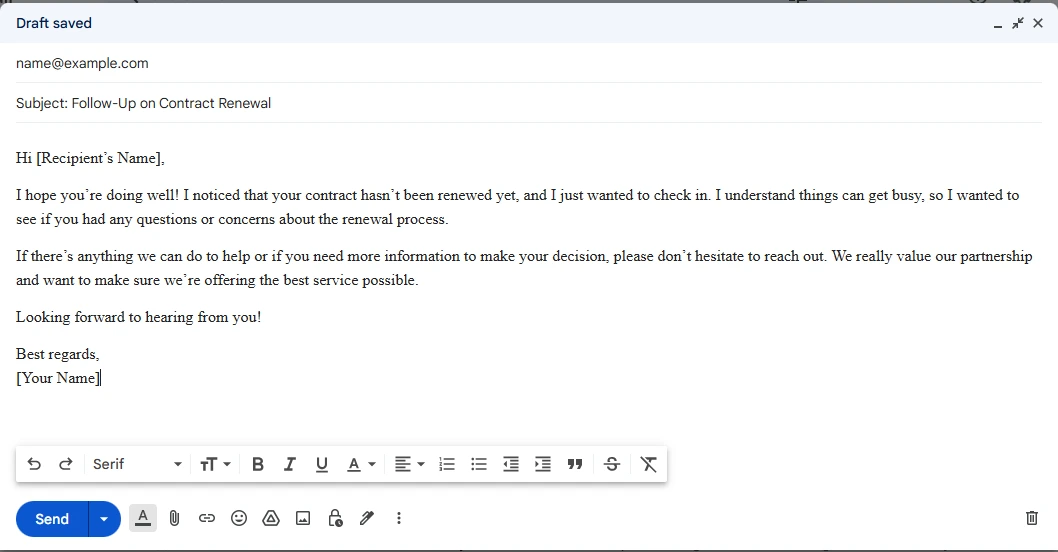
When a client hasn't renewed their contract, Client follow-up important to reach out in a friendly and professional way.
Here’s a simple example:
Subject: Follow-Up on Contract Renewal
Body:Hi [Recipient’s Name],
I hope you’re doing well! I noticed that your contract hasn’t been renewed yet, and I just wanted to check in. I understand things can get busy, so I wanted to see if you had any questions or concerns about the renewal process.
If there’s anything we can do to help or if you need more information to make your decision, please don’t hesitate to reach out. We really value our partnership and want to make sure we’re offering the best service possible.
Looking forward to hearing from you!
Best regards,
[Your Name]
This approach shows you care, invites feedback, and offers assistance, all while leaving the door open for continued collaboration.
15.Following Up Email Templates After Sending a Quote
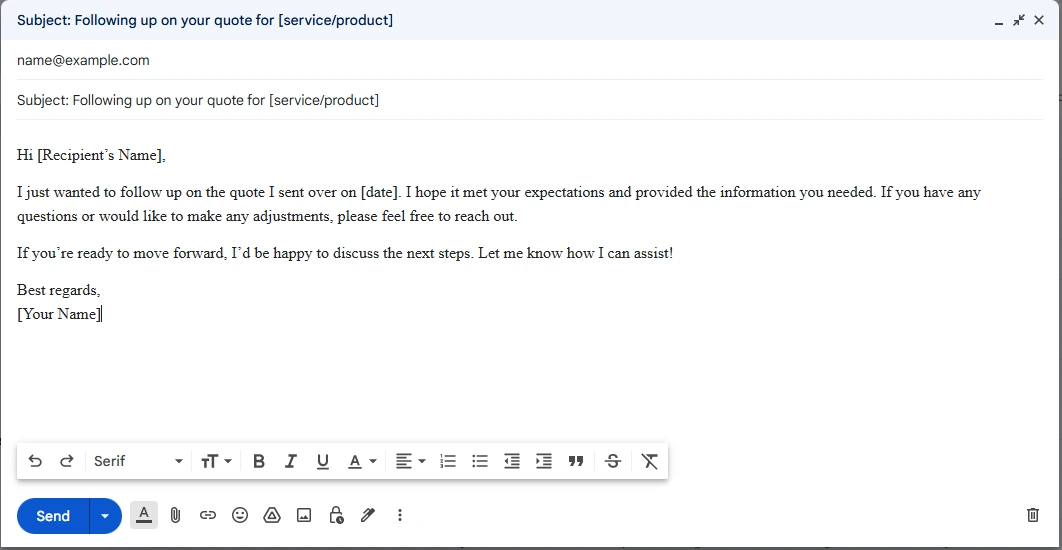
If you've sent a quote but haven't received a response, it’s important to send a friendly follow-up email. This shows you’re still interested in working with them and keeps the conversation going.
Here’s a simple example:
Subject: Following up on your quote for [service/product]
Body:Hi [Recipient’s Name],
I just wanted to follow up on the quote I sent over on [date]. I hope it met your expectations and provided the information you needed. If you have any questions or would like to make any adjustments, please feel free to reach out.
If you’re ready to move forward, I’d be happy to discuss the next steps. Let me know how I can assist!
Best regards,
[Your Name]
This email is polite, clear, and offers the recipient an opportunity to ask questions or confirm their interest. It’s a gentle nudge without being pushy, which can help get the conversation back on track.
16.Following Up Email Templates After Sending Product Samples
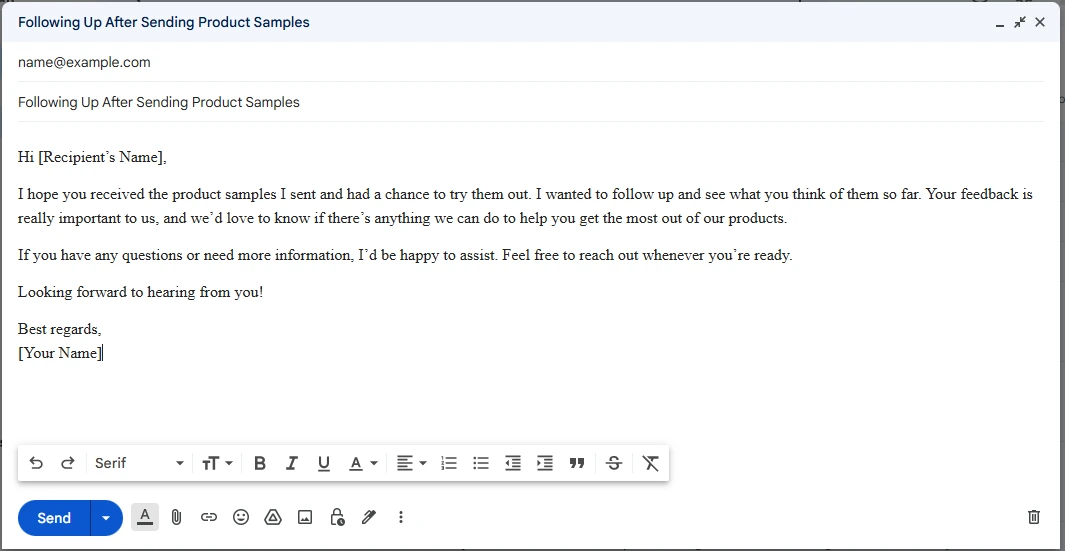
When you deliver product samples, you should follow up with the recipient to see whether they had an opportunity to try them to givecustomer feedback follow-up. This follow-up for feedback request shows your interest in their views and helps to keep the conversation continuing.
Here’s a simple example:
Subject: Hope you enjoyed the product samples!
Body:Hi [Recipient’s Name],
I hope you received the product samples I sent and had a chance to try them out. I wanted to follow up and see what you think of them so far. Your feedback is really important to us, and we’d love to know if there’s anything we can do to help you get the most out of our products.
If you have any questions or need more information, I’d be happy to assist. Feel free to reach out whenever you’re ready.
Looking forward to hearing from you!
Best regards,
[Your Name]
Following up ensures you stay top of mind and shows that you care about your Customer follow-up after product samples.
17.Following Up Email Templates After a Free Trial
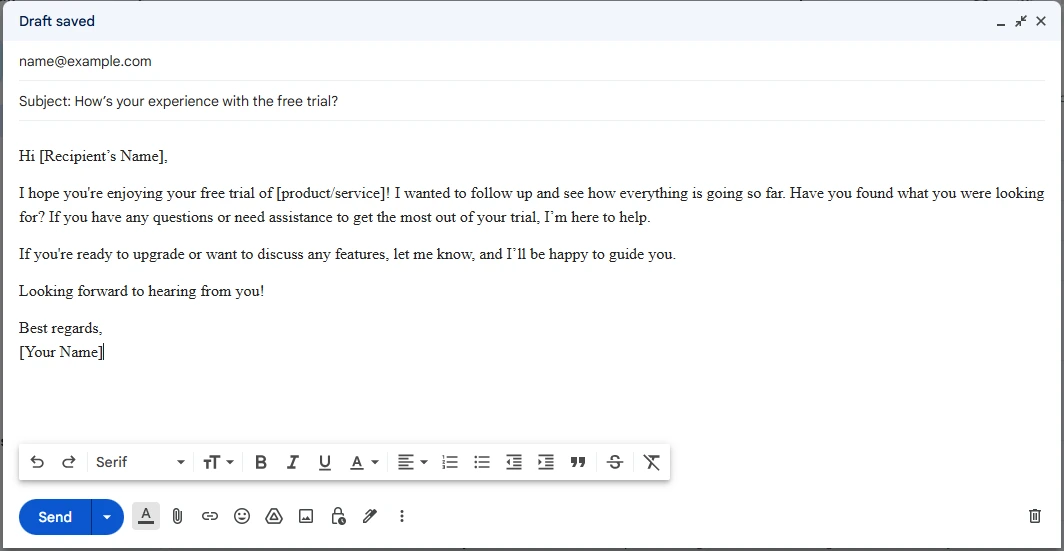
After someone has used your free trial, it’s important to check in and make sure they are getting the most out of it. A thoughtful business follow-up email can encourage them to convert to a paid plan.
Here’s a simple example:
Subject: How’s your experience with the free trial?
Body:Hi [Recipient’s Name],
I hope you're enjoying your free trial of [product/service]! I wanted to follow up and see how everything is going so far. Have you found what you were looking for? If you have any questions or need assistance to get the most out of your trial, I’m here to help.
If you're ready to upgrade or want to discuss any features, let me know, and I’ll be happy to guide you.
Looking forward to hearing from you!
Best regards,
[Your Name]
Follow-up after free trial shows you're proactive, caring, and ready to assist, which increases the chance of converting a free trial user into a paying customer.
18.Following Up Email Templates After the Prospect Asks You to Follow Up
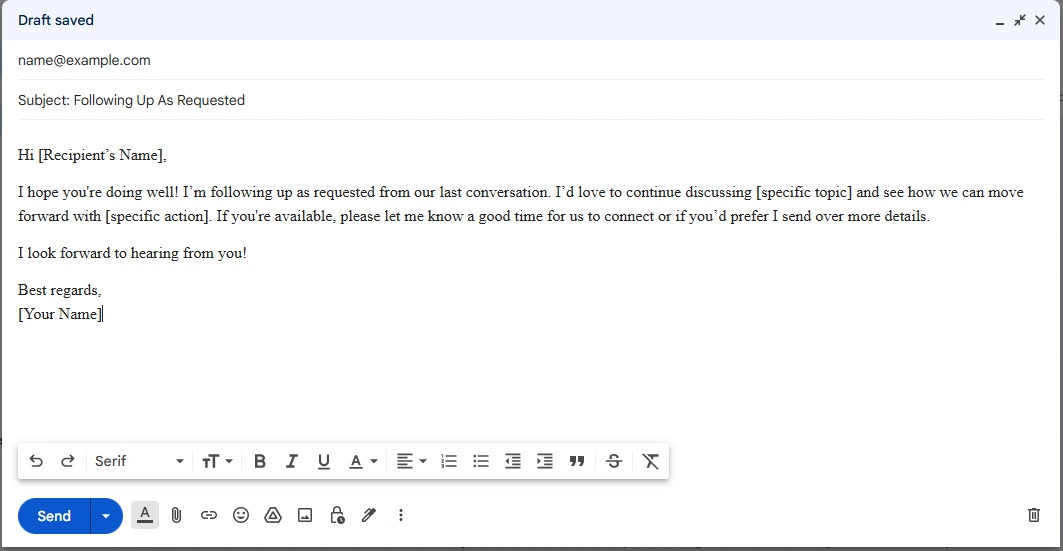
When a prospect asks you to follow up, it's important to do so politely and professionally, keeping the conversation focused on moving forward. This shows you're attentive and value their time.
Here’s a simple example:
Subject: Following Up As Requested
Body: Hi [Recipient’s Name],
I hope you're doing well! I’m following up as requested from our last conversation. I’d love to continue discussing [specific topic] and see how we can move forward with [specific action]. If you're available, please let me know a good time for us to connect or if you’d prefer I send over more details.
I look forward to hearing from you!
Best regards,
[Your Name]
This approach reminds the prospect of the previous discussion and helps set clear next steps. Be respectful of their time and provide options to make it easier for them to respond.
19.Following Up Email Templates to Find the Right Contact
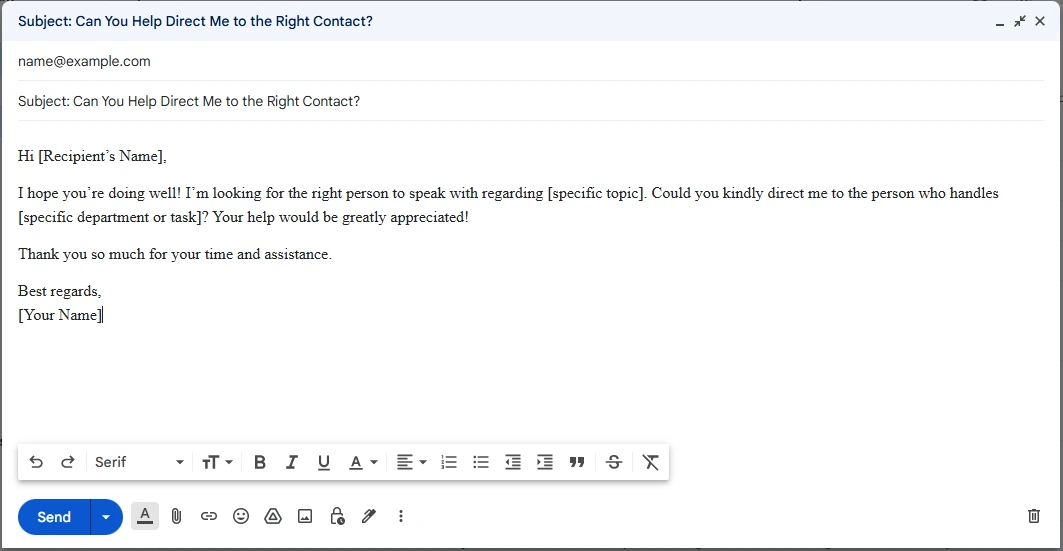
If you're unsure whether you're reaching out to the correct person, it’s important to politely ask for guidance. This way, you show respect for their time while still trying to find the right contact for your needs.
Here’s a simple example:
Subject: Can You Help Direct Me to the Right Contact?
Body: Hi [Recipient’s Name],
I hope you’re doing well! I’m looking for the right person to speak with regarding [specific topic]. Could you kindly direct me to the person who handles [specific department or task]? Your help would be greatly appreciated!
Thank you so much for your time and assistance.
Best regards,
[Your Name]
This approach is polite and efficient. It shows that you respect the recipient’s time while still making progress toward finding the right contact for your inquiry.
20.Following Up Email Templates After An Initial Follow-Up
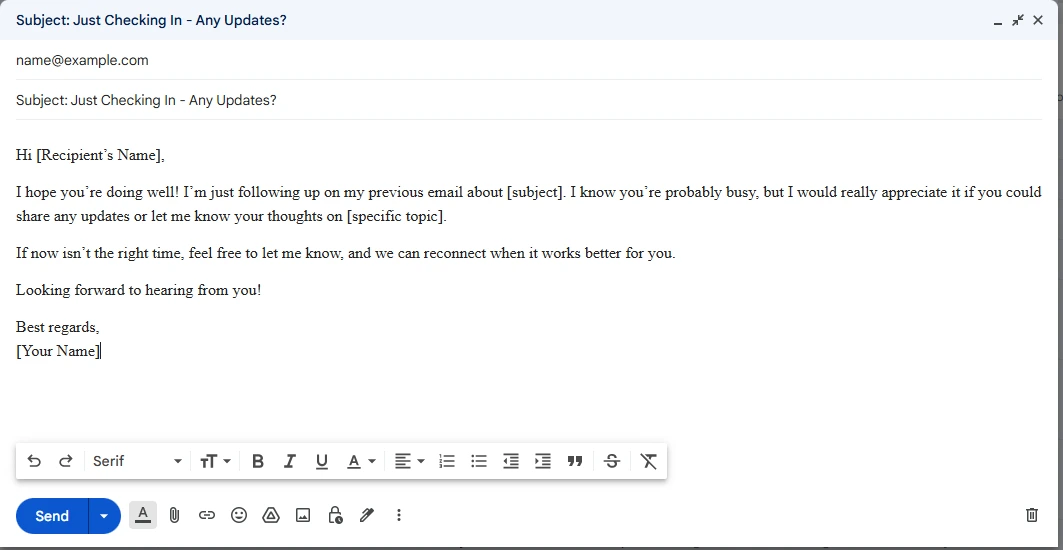
If you've already sent one follow-up email and haven’t received a response, it’s important to send a polite reminder. This shows you're still interested without being pushy.
Here’s a simple example:
Subject: Just Checking In - Any Updates?
Body:Hi [Recipient’s Name],
I hope you’re doing well! I’m just following up on my previous email about [subject]. I know you’re probably busy, but I would really appreciate it if you could share any updates or let me know your thoughts on [specific topic].
If now isn’t the right time, feel free to let me know, and we can reconnect when it works better for you.
Looking forward to hearing from you!
Best regards,
[Your Name]
This follow-up is polite, gives the recipient space, and gently encourages a response. It also shows understanding of their time constraints while keeping the conversation open.
21.Follow-Up Email Templates After Cold Email Promotion
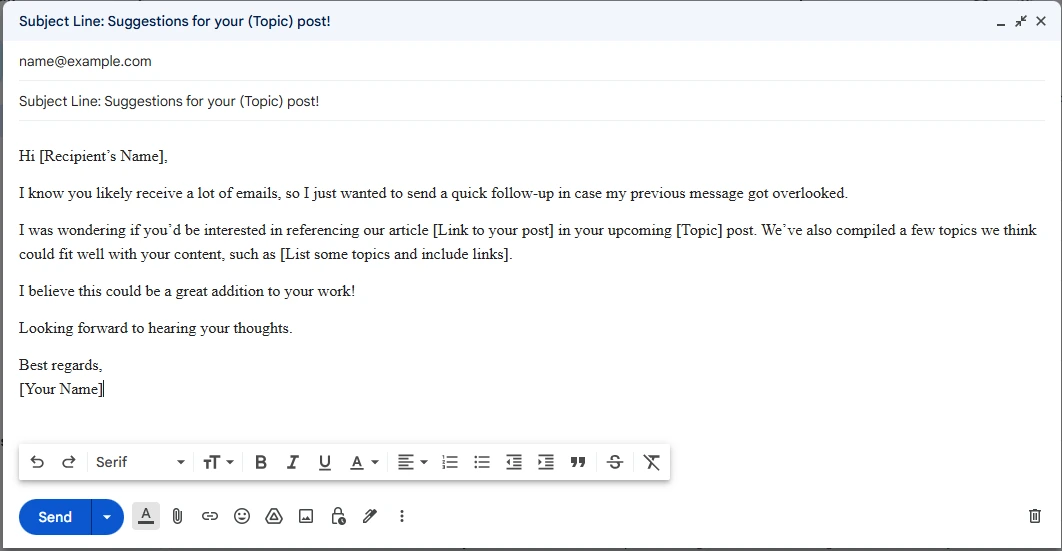
Write Cold emails might be difficult, but a well-written follow-up email provides an additional opportunity to engage. In this email, you should accept that the receiver may be busy and provide specific ideas for how you may add value to their job. This displays that you've considered their requirements and how you might help.
Here’s a simple example:
Hi [Recipient’s Name],
I know you likely receive a lot of emails, so I just wanted to send a quick follow-up in case my previous message got overlooked.
I was wondering if you’d be interested in referencing our article [Link to your post] in your upcoming [Topic] post. We’ve also compiled a few topics we think could fit well with your follow-up email content, such as [List some topics and include links].
I believe this could be a great addition to your work!
Looking forward to hearing your thoughts.
Best regards,
[Your Name]
This approach is polite, offers value, and encourages a response by making it easy for the recipient to say yes.
Legal Compliance in Follow-Up Emails
When sending follow-up emails, ensure compliance with key regulations:
- GDPR (EU): Include clear opt-out options and only email contacts who've given explicit consent
- CAN-SPAM Act (US): Include your physical address and clear unsubscribe options
- CASL (Canada): Ensure you have express or implied consent for follow-ups
- Document how and when you received permission to email each contact
- Include your company's physical address in every email
- Honor unsubscribe requests within 10 business days
Conclusion
Writing the ideal follow-up email after no response can greatly improve your communication efforts. Here are the most important takeaways to consider:
- Timing is important: Send follow-up emails at the right moment, without being too soon or excessively late.
- Be clear and concise: Keep your emails short, to the point, and simple to understand.
- Personalize your message: Adding a personal touch shows that you care about the person you'reemailing.
- Offer value: Provide useful information or show how your message benefits the recipient.
- Be polite and patient: Always be respectful and avoid sounding forceful or aggressive.
- Have a clear next step: Make sure the receiver understands the action you want them to do.
Now that you've learned these tips, it's time to apply them to your emails. Whether you're following up after a meeting, a demo, or a simple question, these tips can help you write emails that attract responses.
If you're ready to step up your email game, we've got you covered. Sign up for our free email templates, attend our professional communication webinar, or read our other blog posts to learn more about boosting your email writing skills. Don't miss up the opportunity to improve your email performance and receive greater results.If you want to learn best time for sending cold emails, Check out our blog The Ultimate Guide to the Best Time for Sending Cold Emails
FAQs
1.How many follow-up emails should I send?
The best follow-up email strategies suggest sending 2–3 follow-ups. Sending too many might disturb potential customers, while too few could mean missed opportunities. Use tools like automated email follow-up tools to manage this balance.
2.Why send follow-ups?
Follow-up email sequences are important for keeping your message top of mind. They show determination, build trust, and boost chances of response. It's one of the best email outreach customer engagement strategies for boosting sales with follow-up emails.
3.How often should you send follow-up emails?
Timing matters! Wait 2–5 days between follow-ups. This ensures you’re engaging without overwhelming. Effective email follow-up timing plays a big role in email response rate optimization.
4.What should I do if I still don’t get a response after multiple follow-up emails?
If there’s no response, refine your follow-up email templates. Personalize them and explore email outreach tools or sales outreach email automation tools to test new approaches.
5.How do I automate a follow-up email in Gmail/Outlook?
Use Gmail follow-up process or Outlook email automation features. Many email automation software options help schedule and send reminders for prospect engagement via email easily.
What to read next
Absolutely! Boost Inbox is compatible with most major email service providers.
The warmup process duration may vary depending on your email volume, but it typically ranges from a few days to a couple of weeks.
Yes, Boost Inbox offers dedicated customer support to assist you throughout the warmup process.
While it's possible, it's best to start the warmup process from the beginning with Boost Inbox for optimal results.
